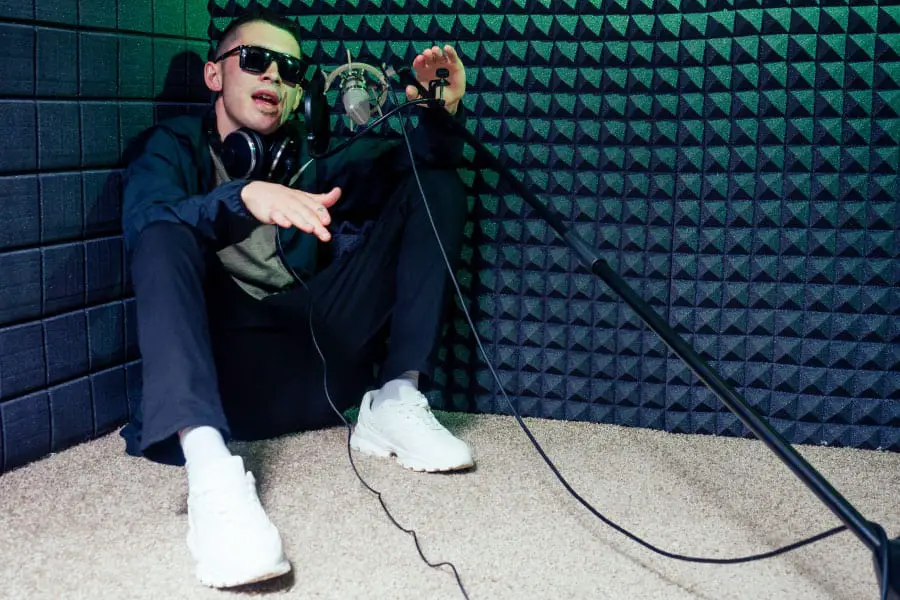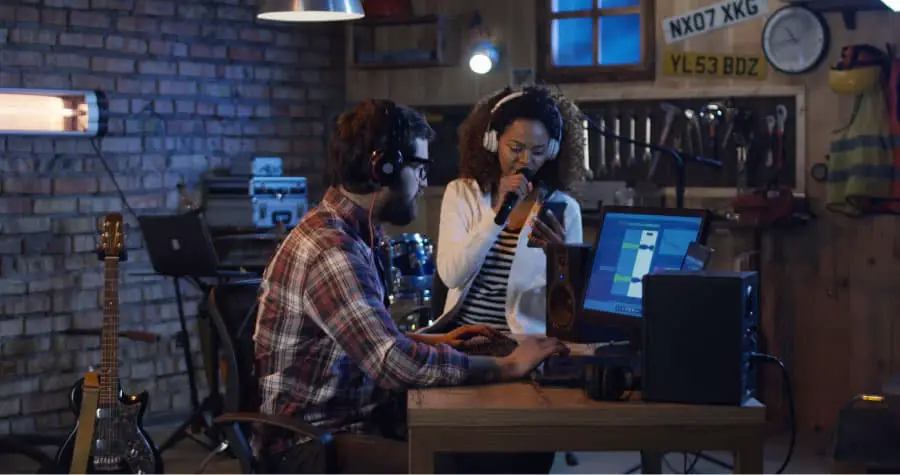
I have always tried my utmost to record singers when they are in a standing position and not seated while in my studio. Some singers don’t know how the body works when it comes to singing, but I do, so I understand what parts of the body and what mechanisms are at work when you sing from a seated or standing position. Due to this, I always advocated that when recording vocals, you should stand. This is why.
It would be best if you always recorded vocals in a standing position. When you are standing, the diaphragm and ribcage have space to expand, allowing you to take in sufficient air and control that air better. While sitting, the organs are compressed, not allowing for any expansion, and this also directly affects certain vocal techniques.
This article will cover the body parts and techniques affected while you sing when you are in a seated position. We will then look at how much of a hindrance this can be to your vocal performance and what you can do to rectify it. Then I will break down for you how I record vocals in my studio, and lastly, I will give you some tips on the best practices for recording vocals.
How to sing correctly
This could be an article unto itself, but we will correlate certain singing techniques, principles, and parts of the body that would affect singing while standing or seated. Then we will discuss any principles or techniques there are which are related to recording, if any, moreover relating them to standing and seated positions to see if a recording is affected by this.
Parts of the body that affect singing while seated
The diaphragm
The diaphragm is a large muscle that sits just above your stomach muscles and stretches across your rib cage’s lower part. This muscle separates your heart and lungs from the rest of the organs that lay within the body. The diaphragm is critical in playing a role to sing properly. This is because it is fundamental in the role of correct breathing, contracting, and relaxing when you are inhaling and exhaling air from your lungs.
Because there is a direct connection between being able to sing well and breathing, the diaphragm has to work and function correctly for the breath to be controlled correctly. For the most part, a flat and contracted diaphragm has much better control over the air supply that passes through your vocal cords, thus giving you most of the control you need when you sing.
Watch Katarina H explain how you breathe from your diaphragm for a better singing technique.
The rib cage
In a seated position, especially with a singer who slouches, the rib cage cannot expand when air is inhaled. This directly affects the amount of air you can breathe in. Moreover, if you do not take in the necessary amount of air, you won’t support great vocal techniques such as sustain, control, and power in your notes.
The same concept as with the diaphragm applies to the ribcage because the organs are compressed, and the diaphragm has nowhere to move, so hence, neither does the rib cage.
You have to remember that the correct breathing technique for singing is with your stomach and not with your chest. This does not mean that the lungs and ribcage do not expand. It just means they expand differently.
Watch 21 day vocal trainer give you some tips on rib cage expansion.
Singing techniques that are affected while seated
Belting
This is a specific vocal technique that allows the singer to project and “throw” their voice to a large degree. A singer will carry their chest voice above the break or passaggio. This technique is sometimes described as a chest voice that has been taken higher (high chest voice). One thing to note that if this technique is done incorrectly, a singer will damage their voice.
The diaphragm plays a crucial role in helping to control this technique and produce it properly. When a singer uses the belting technique, they will feel pressure in their abdomen and on their diaphragm.
Can you sing well while seated?
The diaphragm plays a large role in singing, and its crucial function is to expand and contract while breathing in and out correctly. This is hindered when you are in a seated position. Due to the fact you are in a seated position, your internal organs are compressed (everything is on top of each other), and because of this, it may be difficult to breathe in a deep amount of air, or rather enough for you to control sustained exhaling which is one of the most important aspects of being able to sing well.
On account of the abdominal region being compressed in a seated position, the diaphragm cannot expand and function correctly. This is because your stomach and other organs are already compressed; hence, the diaphragm cannot expand when breathing in.
When in a standing position, your body is elongated, and there is no compression of the organs. Therefore your diaphragm can expand and function properly, taking in the correct amount of air you need in order to be able to sing a passage or phrase.
Being able to control your diaphragm properly and regulate and control your air intake while directly affect the technique of belting. Granted, some singers don’t use this technique, or perhaps they do; they just don’t know that they do. In any event, a singer will not incorporate this technique into their style (or not as well) while in a seated position.
If you would like some online lessons or courses on singing, then be sure to check out our online music academy where we offer courses and lessons on a ton of instruments – Master Music Talent Academy

How to record vocals
For the most part, I have never recorded myself or another vocalist while they were seated because I know all the mechanisms at play when a person is singing. I always maintain that you can sing easier when you are in a standing position (perhaps not better), however much easier.
This is because the diaphragm not being able to function correctly, which directly impacts certain vocal techniques that most singers don’t even know they are using.
If an artist plays guitar or piano and prefers to sit when they sing, I like to record them playing their instrument first and then ask if they will do a vocal take in a standing position.
If they are adamant that they want to sit while recording vocals, I will ask them to do a version standing up and use it for double-tracking. This will give the track some extra nuances, make it fuller, and sound more lively.
Best practices for recording vocals
These are the tips I give to any singer that I record in my studio. It helps them to relax and to give a better performance when it comes time to record. Whether they choose to sit or stand, most of these tips will apply to them and improve their performance.
- Stand while recording vocals
- Warm-up before your recording
- Drink enough fluids
- Get rest the night before
- Do not drink or smoke during your recording
- Memorize what you are recording
Conclusion
We conclude that it is better to stand when you sing for recording purposes, and actually, it is better if you stand while singing in most instances. This is because it is easier to sing when standing when we consider singing from the body’s anatomy and how it functions. You may not sing better in terms of technique, but the process of singing will be much easier if you stand.
The parts of the body that are affected drastically when you sit are the rib cage and the diaphragm, and these two parts of the body drastically affect the amount of air you can inhale and then the control of that air. (exhaling).
Hence when you need to record vocals in the studio and give a good performance, you need all the help you can get because once you have recorded your vocal lines, that is that, and those are the lines you will hear on your track or album.
Hence it is always better to be prepared and know any advantages that will aid you in your recording performance.

